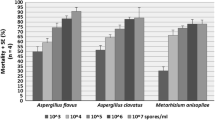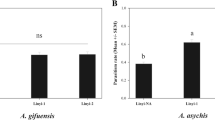Abstract
Large (6.7–8.4 μm in length) and small (3.8–6.7 μm in length) spored strains ofVerticillium lecanii (Zimm) Viégas killed similar numbers of adults of the aphids treated with aqueous spore suspensions. However, when these strains were compared by determining the proportions of progeny aphids acquiring infection from treated adults, i.e. a measure of epizootic potential, large differences emerged; only large-spored strains exhibited as strong an epizootic potential as the standard strain, 1–72, with mean progeny mortality ratios (test/standard) close to 1.0. Further experiments indicated that the speed of germination, fastest for large-spored strains, accounted for the greater epizootic potential of such strains. In addition, the mode of sporulation of large-spored strains on aphid cadavers probably also contributed to the more efficient spread of such strains. A general conclusion was reached that measurement of the effectiveness of a pathogen against a host insect must be based on many factors, in addition to virulence against a single developmental stage.
Résumé
Les souches deVerticillium lecanii (Zimm) Viégas à grandes spores (6,7 à 8,4 μm de longueur) et à petites spores (3,9 à 6,7 μm) tuent un nombre analogue de pucerons adultes traités par des suspensions de spores dans l'eau. Cependant, lorsque ces souches sont comparées d'après l'importance de l'infection dans la descendance des adultes traités, c'est-à-dire d'après le potentiel épizootique, il apparait de grandes différences; seules les souches à grandes spores ont un potentiel épizootique égal à celui de la souche étalon, 1.72. Des essais complémentaires montrent que la vitesse de germination, plus rapide chez les souches à grandes spores, intervient dans leur meilleur potentiel épizootique. En plus, le mode de sporulation des souches à grandes spores sur les pucerons morts contribue aussi probablement à une plus efficace dispersion de ces souches. On en tire la conclusion générale que la mesure de l'efficacité d'un agent pathogène à l'égard d'un insecte hôte doit être fondée sur beaucoup de facteurs, en plus de la virulence, agissant sur un seul stade de développement.
Similar content being viewed by others
References
Fargues, J. &Vey, A. — 1974. Modalités d'infection des larves deLeptinotarsa decemlineata parBeauveria bassiana au cours de la mue. —Ento mophaga, 19, 311–323.
Hall, R.A. — 1976. A bioassay of the pathogenicity ofVerticillium lecanii conidiospores on the aphid,Macrosiphoniella sanborni. —J. Invertebr. Pathol., 27, 41–48.
Hall, R.A. — 1977. The potential of the fungus,Verticillium lecanii, as a microbial control agent of glasshouse aphid pests. —Ph. D. thesis, Univ. Southampton.
Hall, R.A. — 1982a. A new insecticide against greenhouse aphids and whitefly: the fungus,Verticillium lecanii. —Ohio Florists' Assoc. Bull., No. 626, 3–4.
Hall, R.A. — 1982b. Control of whitefly,Trialeurodes vaporariorum and cotton aphid,Aphis gossypii in glasshouses by two isolates of the fungus,Verticillium lecanii. —Ann. Appl. Biol., 101, 1–11.
Hall, R.A. &Burges, H.D. — 1979. Control of aphids in glasshouses with the fungus,Verticillium lecanii. —Ann. Appl. Biol., 93, 235–246.
Author information
Authors and Affiliations
Rights and permissions
About this article
Cite this article
Hall, R.A. Epizootic potential for aphids of different isolates of the fungus,Verticillium lecanii . Entomophaga 29, 311–321 (1984). https://doi.org/10.1007/BF02372119
Issue Date:
DOI: https://doi.org/10.1007/BF02372119




